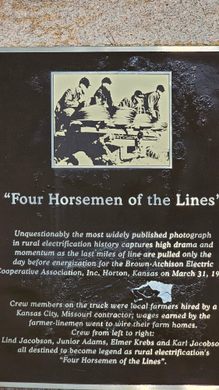'Four Horsemen of the Lines' Monument
A plaque recognizes "unquestionably the most widely published photograph in rural electrification history."
“Everything’s up to date in Kansas City,” goes the Rodgers and Hammerstein song written about life on the prairie in the 1930s. While electricity and cable cars had come to the cities, in rural areas such as Horton, Kansas, people were still reliant on burning wood, coal, or kerosene for energy and heat.
The Rural Electrification Act was signed into law on May 20, 1936, formalizing one of President Franklin D. Roosevelt’s New Deal programs. The act led to the establishment of rural electric cooperatives, which helped to spread the expense among farmers who had been hard hit by the effects of the Great Depression.
In Kansas, there was a wave of enthusiasm resulting from a December 1936 meeting with REA representatives, and the Brown-Atchison Electric Cooperative Association was established as the first rural electric cooperative in Kansas. Because the cooperative was member-owned, many of the farmers who sought electricity became linemen, putting up poles and unspooling miles of electrical copper wire themselves, working together for the collective good.
On March 31, 1938, four local farmers, working as linemen, pulled the last miles of line on a truck. A photo was taken, showing their excitement and determination in seeing this worker-led project through. The next day, a ceremonial switch was thrown in Washington, D.C., and the lives of rural Kansans were forever changed.
The photo of farmers Lind Jacobson, Junior Adams, Elmer Krebs and Karl Jacobson became known as the “Four Horsemen of the Lines.” It would be reproduced and displayed in the Smithsonian, and became the symbol of the rural electrification project across the country.
To this day, Horton is known as “The Electric City,” and the Brown-Atchison Cooperative continues to serve thousands of residents in Northeast Kansas. The photo remains a vital representation of worker power and of the act that made the greatest impact in rural American history.
Know Before You Go
The historic marker is located on the Brown-Atchison Electric Cooperative Association building, towards the south side. A nearby historic marker on 15th Street and 5th Avenue recognizes the site of rural Kansas's first power pole.
Plan Your Trip
The Atlas Obscura Podcast is Back!

















Follow us on Twitter to get the latest on the world's hidden wonders.
Like us on Facebook to get the latest on the world's hidden wonders.
Follow us on Twitter Like us on Facebook